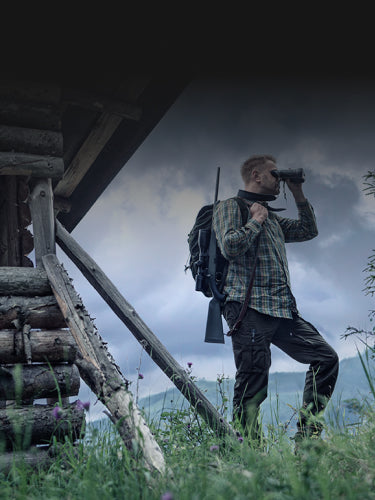Hunting success often comes down to one thing: seeing your prey before it sees you. Whether you’re posted up before first light or tracking a wounded animal through thick brush, your ability to spot game fast and early makes the difference between a full cooler and the long walk of shame back to your truck.
Enter the Pulsar Oryx LRF XG35—Pulsar’s brand-new, cutting-edge thermal imaging monocular built around the latest advances in digital thermal tech. Rugged yet compact, it packs a high‑resolution 640×480 @ 12 µm sensor, crisp 1024×768 AMOLED display, smooth 2.5–20× zoom, and a built‑in laser rangefinder reaching up to 1,500 m.
Thermal Gives You First Sight
Animals have excellent natural camouflage, especially at dawn, dusk, or in low-contrast terrain. Traditional optics rely on light. Thermal doesn’t. The Oryx detects body heat, not movement or color, letting you scan treelines, fields, and thick cover where animals might be bedded down or slowly moving. If it’s warm-blooded and nearby, you’ll see it—day or night.
Whether you’re targeting hogs, coyotes, deer, or predators, first sight often means first shot. With the Oryx, you’re not waiting for game to step into an opening. You’re tracking them while they think they’re hidden.

Rugged and One-Handed for the Real World
Built smaller and tougher than Pulsar’s earlier Axion models, the Oryx boasts IP67 waterproofing, meaning it’s sealed against rain, dust, and brief submersion. It’s ambidextrous as well, fully operable with one hand, so your trigger hand stays ready.
Clip it to your bino harness, shove it in a coat pocket, or keep it ready in the truck. No bulk, no hassle.
New Green Hot Palette: See More, Strain Less
The Oryx introduces a new green hot thermal palette, inspired by traditional night vision devices and much gentler on the eyes. Unlike stark white or black hot modes, green hot is easier to use for extended viewing—especially in low-light environments where eye fatigue creeps in fast. It preserves your natural night vision better and makes heat signatures pop clearly without the glare.
Know the Range, Make the Shot
When hunting in darkness or varied terrain, judging distance by eye is a guessing game—and bad guesses ruin hunts. The Oryx’s built-in laser rangefinder gives you the exact distance to your target instantly. That’s essential for lining up ethical shots or planning a silent stalk without blowing your position. No external gear, no second-guessing.
And while the Oryx excels at night, it’s not just a nighttime tool. Because it detects heat, not visible light, it performs just as well in broad daylight. There’s no screen washout, no glare, and no drop in detection range. You can scan sunlit pastures, open plains, or rocky slopes in full daylight and still spot game hiding in plain sight. The Oryx gives you thermal clarity around the clock—day or night—whenever and wherever you hunt.
Real-World Hunting Scenarios
Here’s how hunters actually use the Oryx in the field:
-
Pre-hunt scanning: Before climbing into the blind or stand, use the Oryx to sweep the area and catch movement others miss.
-
Spot-and-stalk hunting: Stay low and scan forward without exposing yourself—thermal lets you track game before you step into view.
-
Night predator and hog control: No spotlight needed. Thermal gives you total visibility without alerting the animal.
-
Post-shot recovery: Blood trails fade. Heat doesn’t. Use the Oryx to locate downed animals by spotting body heat, disturbed ground, or warm blood tracks.
-
Safety and awareness: Identify livestock, other hunters, or large animals sharing your trail before you’re too close for comfort.
What You’re Missing Without One
Hunters who go without thermal imaging monoculars are walking blind. They’re relying on shadows and hope. They’re missing animals just yards away. They’re misjudging distance, botching stalks, and losing valuable time in recovery. The Pulsar Oryx LRF XG35 fills in those gaps. It doesn’t replace your skills—it sharpens them. It doesn’t just help you see more—it helps you see first.
Frequently Asked Questions
1. How does thermal imaging help with hunting?
Thermal imaging helps by detecting body heat, allowing you to spot warm-blooded animals in various conditions.
2. Is the Pulsar Oryx LRF XG35 suitable for all weather conditions?
Yes, the Oryx is IP67 waterproof and can withstand rain, dust, and brief submersion.
3. How does the green hot thermal palette improve visibility?
The green hot palette is easier on the eyes and allows for clearer heat signature detection, especially in low-light environments.
4. How does the built-in laser rangefinder benefit hunters?
The laser rangefinder provides instant distance measurements, essential for accurate shot placement and stalking.
5. Can the Oryx be used during daylight hours?
Yes, the Oryx performs well in daylight as it detects heat, not visible light, ensuring thermal clarity at any time of day.




